Characterization of the GNSS RFI Threat to DFMC GBAS Signal Bands
Abstract
:1. Introduction
2. RFI Data Capture and Event Classification
2.1. RFI Monitoring Network
2.2. RFI Event Detection
2.3. Automatic Event Classification
3. Data Analysis and Results Discussion
3.1. L1/E1, L5/E5a and E5b Frequency Bands
3.2. L1/E1 and G1 Frequency Bands
3.3. New RFI Type Observations
4. Conclusions and Recommendations
- Both the number of events observed, as well as the amount of time per day with interference present, are the highest on the L1/E1 frequency band on all sites used in the study.
- The L1/E1 frequency band is impacted most by the assumingly unintentional narrowband interference caused by malfunctioning GNSS equipment. As low-cost multi-frequency navigation receivers proliferate, it is believed that the total rate of the narrowband EMI in the L5/E5a and E5b bands will increase as a consequence, potentially reaching parity with the rates now observed in L1/E1.
- RFI events affecting L5/E5a only are less common. In the majority of cases, when there is interference on L5/E5a, L1/E1 is also affected (1.3 to 1 E5a to L1/E1 + E5a ratio).
- The average ratio of RFI on L1/E1 vs. RFI on L5/E5a is approximately 3.9 to 1. The ratio for RFI on L1/E1 vs. RFI on both L1/E1 and L5/E5a is approximately 5.1 to 1.
- Both the total number of events and dominant type of the interference signal, as well as the impact ratios (L1 vs. L5, L1 vs. L1, L5, etc.), depend strongly on the site and time period considered.
- When the combination of wideband and time-modulated sources is considered, they become the majority of events detected at the majority of the sites (here, all sites except for Moss, Norway). In all cases, the combination is within the same order of magnitude as the narrowband events, and therefore should not be ignored.
- Significant month-to-month variation was observed in both total RFI occurrence and the impact ratios.
- GNSS signal jamming is a dynamic/evolving threat. While several of the new jamming signal types observed within this monitoring campaign are variations of existing modulations and concepts, e.g., exponentially swept vs. linearly swept, this should be taken into account when/if considering use of in-receiver mitigation schemes.
- The prevalence of RFI is higher than initially expected and could be a factor for continuity. Based on the observation that the GBAS system has low tolerance to loss of C/N0 before observations are discarded by low-signal-power monitor, and lower starting C/N0 due to characteristics of MLAs, antennas siting relative to roadways are believed to be very important in light of the RFI occurrence rate results.
- Given the observed average ratio of 1 to 3.9 of the interference on L5/E5a vs. interference on L1/E1, inclusion of an additional fallback mode should be subjected to a cost–benefit analysis given that the proportion of events which affect the L5/E5a band only is within an order of magnitude of the occurrence rate on L1/E1.
- While a histogram of in-band power levels was not presented here, this should be evaluated when considering ground antenna siting, as distance alone may be insufficient to meet system Electro-Magnetic Interference (EMI) assumptions. Alternately, it may be necessary to rely on earthworks or other obstructions to local roadways and other transportation infrastructure.
- While new types of jamming signals observed within this monitoring period are variations of existing modulations and concepts, e.g., exponentially swept vs. linearly swept, this should be taken into account when/if considering use of in-receiver mitigation schemes.
Author Contributions
Funding
Institutional Review Board Statement
Informed Consent Statement
Data Availability Statement
Acknowledgments
Conflicts of Interest
References
- STRIKE3—Monitor, Detect, Characterize, Standardize, Mitigate and Protect. Available online: http://www.gnss-strike3.eu/ (accessed on 3 October 2022).
- Rødningsby, A.; Morrison, A.; Sokolova, N.; Gerrard, N.; Rost, C. RFI Monitoring of GNSS Signals on Norwegian Highways. In Proceedings of the 33rd International Technical Meeting of The Satellite Division of the Institute of Navigation (ION GNSS+ 2020), Virtual, 21–25 September 2020. [Google Scholar]
- Gerrard, N.; Morrison, A.; Sokolova, N.; Rødningsby, A.; Rost, C. Exploration of Unintentional GNSS RFI Sources: Causes, Occurrence Rates, and Predicted Future Impact. In Proceedings of the 35th International Technical Meeting of the Satellite Division of The Institute of Navigation (ION GNSS+ 2022), Denver, CO, USA, 19–23 September 2022. [Google Scholar]
- Warburton, J.; Tedeschi, C. GPS Privacy Jammers and RFI at Newark: Navigation Team AJP-652 Results. In Proceedings of the 12th International GBAS Working Group Meeting (I-GWG-12), Atlantic City, NJ, USA, 17 November 2011. [Google Scholar]
- Pullen, S.; Gao, G.; Tedeschi, C.; Warburton, J. The impact of uninformed RF interference on GBAS and potential mitigations. In Proceedings of the 2012 Institute of Navigation International Technical Meeting (ITM 2012), Newport Beach, CA, USA, 30 January–1 February 2012. [Google Scholar]
- ICAO Working Paper: NSP 5 WP 41—DFMC GBAS Conceptual Framework—SESAR Joint Undertaking; ICAO: Montreal, QC, Canada, 2018.
- ICAO Working Paper: NSP 6 WP 17—Alternative Architecture for Dual Frequency Multi-Constellation GBAS; ICAO: Montreal, QC, Canada, 2020.
- SESAR Joint Undertaking: Dual Frequency Multi Constellation DFMC GBAS. Available online: https://www.sesarju.eu/sesar-solutions/dual-frequencymulti-constellation-dfmc-gbas-gast-d-extended-scope (accessed on 3 October 2022).
- Murphy, T.; Harris, M.; Saito, S. Alternative architecture for dual frequency multi- constellation GBAS. In Proceedings of the 34th International Technical Meeting of the Satellite Division of the Institute of Navigation (ION GNSS+ 2021), St. Louis, MS, USA, 20–24 September 2021. [Google Scholar]
- Jada, S.; Bowman, J.; Psiaki, M.; Fan, C.; Joerger, M. Time-Frequency Analysis of GNSS Jamming Events Detected on U.S. Highways. In Proceedings of the 35th International Technical Meeting of the Satellite Division of The Institute of Navigation (ION GNSS+ 2022), Denver, CO, USA, 19–23 September 2022. [Google Scholar]
- Fors, K.; Stenberg, N.; Nilsson, T. Using the Swedish CORS network SWEPOS for GNSS interference detection. In Proceedings of the 34th International Technical Meeting of the Satellite Division of The Institute of Navigation (ION GNSS+ 2021), St. Louis, MS, USA, 24 September 2021. [Google Scholar]
- Morrison, A.; Sokolova, N.; Hakegard, J.E.; Bryne, T.H.; Ruotsalainen, L. A Multi-Site Quad-Band Radio Frequency Interference Monitoring Alerting and Reporting System. In Proceedings of the 2020 European Navigation Conference (ENC GNSS 2020), Virtual, 23 November 2020. [Google Scholar] [CrossRef]
- Morrison, A.; Sokolova, N.; Swinden, R.; Musumeci, L.; Caparra, G. Advanced RFI Detection, Alert and Analysis System Design and Monitoring Campaign Results. In Proceedings of the NAVITEC 2022, Virtual, 5–7 April 2022. [Google Scholar]
- Morrison, A.; Sokolova, N.; Gerrard, N.; Rødningsby, A.; Rost, C.; Ruotsalainen, L. RFI Considerations for Utility of the Galileo E6 Signal. In Proceedings of the 34th International Technical Meeting of the Satellite Division of The Institute of Navigation (ION GNSS+ 2021), St. Louis, MS, USA, 20–24 September 2021. [Google Scholar]
- Diez, A.; Morrison, A.; Sokolova, N. Automatic classification of RFI events from a multi-band multi-site GNSS monitoring network. In Proceedings of the 35th International Technical Meeting of The Satellite Division of the Institute of Navigation (ION GNSS+ 2022), Denver, CO, USA, 19–23 September 2022. [Google Scholar]
- Diez, A.; Morrison, A.; Sokolova, N. Automatic GNSS RFI Classification Challenges. Eur. J. Navig. 2022, 22, 12–21. [Google Scholar]
- Morrison, A.; Sokolova, N.; Gerrard, N.; Rødningsby, A.; Rost, C.; Ruotsalainen. Radio frequency interference considerations for utility of the Galileo E6 signal based on long term monitoring by ARFIDAAS. NAVIGATION J. 2022; accepted. [Google Scholar]
- RTCA DO-229D; Minimum Operational Performance Standards for Global Positioning System/Wide Area Augmentation System Airborne Equipment. RTCA: Washington, DC, USA, 2020.
- RTCA DO-292; 2004 Edition, Assessment of Radio Frequency Interference Relevant to the GNSS L5/E5A Frequency Band. RTCA: Washington, DC, USA, 2004.
- RTCA DO-301; Minimum Operational Performance Standards (MOPS) for GNSS Airborne Active Antenna Equipment for the L1 Frequency Band. RTCA: Washington, DC, USA, 2006.
- RTCA DO-373; MOPS for GNSS Airborne Active Antenna Equipment for the L1/E1 and L5/E5a Frequency Bands. RTCA: Washington, DC, USA, 2018.
- Grabowski, J.C. Field Observations of Personal Privacy Devices. In Proceedings of the 2012 Institute of Navigation International Technical Meeting (ITM 2012), Newport Beach, CA, USA, 30 January–1 February 2012. [Google Scholar]
- Kraus, T.; Bauernfeind, R.; Eissfeller, B. Survey of In-Car Jammers—Analysis and Modeling of the RF Signals and IF Samples (Suitable for Active Signal Cancelation). In Proceedings of the 24th International Technical Meeting of The Satellite Division of the Institute of Navigation (ION GNSS 2011), Portland, OR, USA, 19–23 September 2011. [Google Scholar]
- Mitch, R.H.; Dougherty, R.C.; Psiaki, M.L.; Powell, S.P.; O’Hanlon, B.W.; Bhatti, J.A.; Humphreys, T.E. Signal Characteristics of Civil GPS Jammers. In Proceedings of the 24th International Technical Meeting of The Satellite Division of the Institute of Navigation (ION GNSS 2011), Portland, OR, USA, 19–23 September 2011. [Google Scholar]


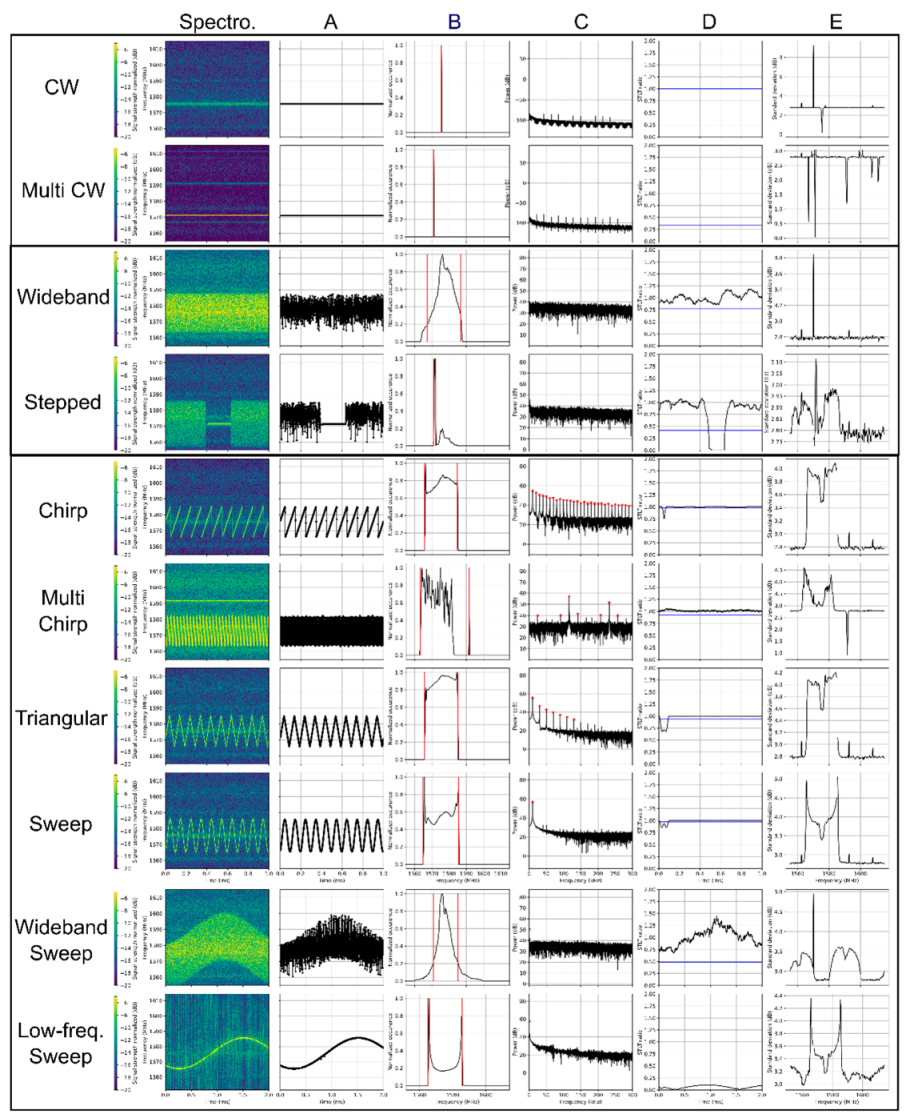
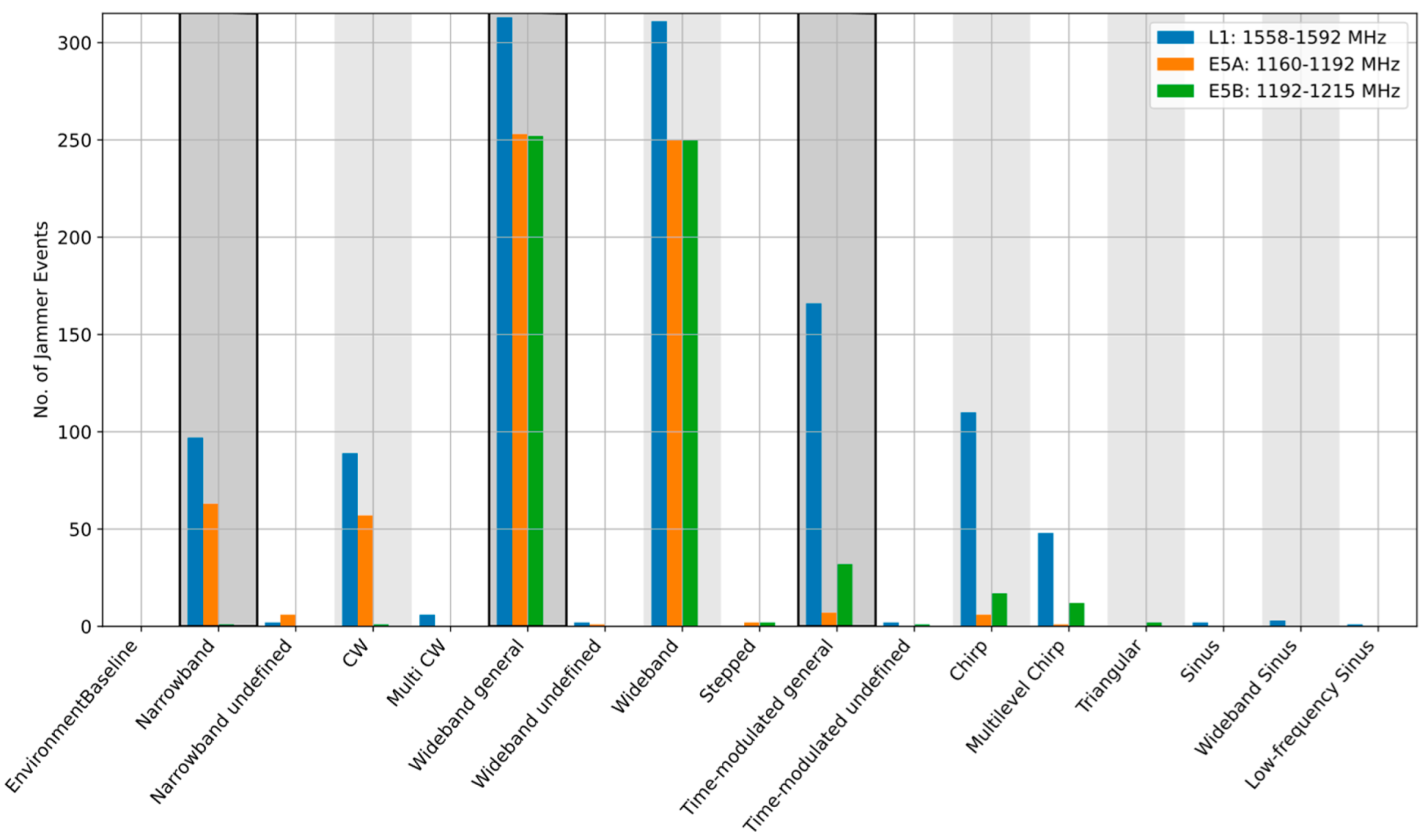
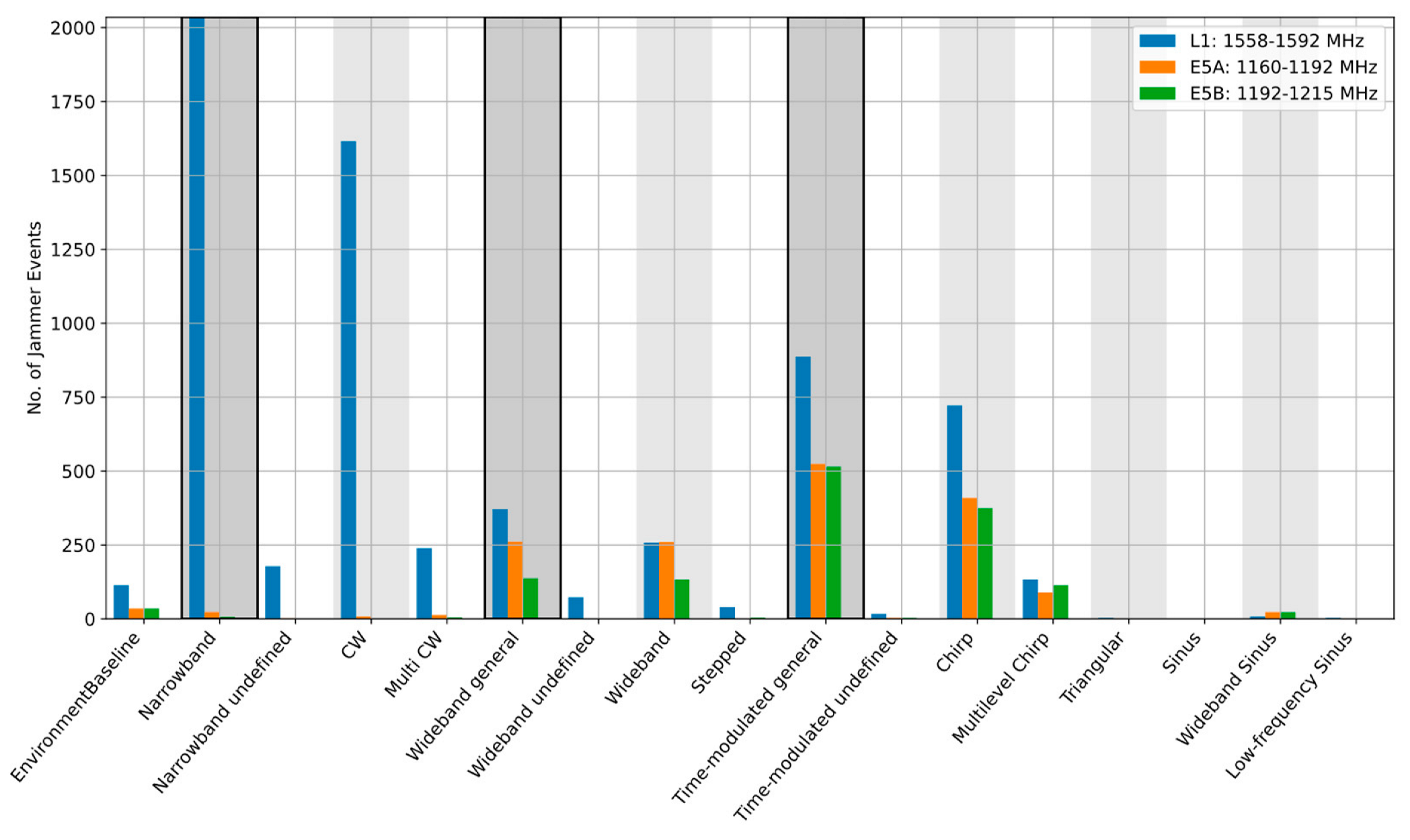
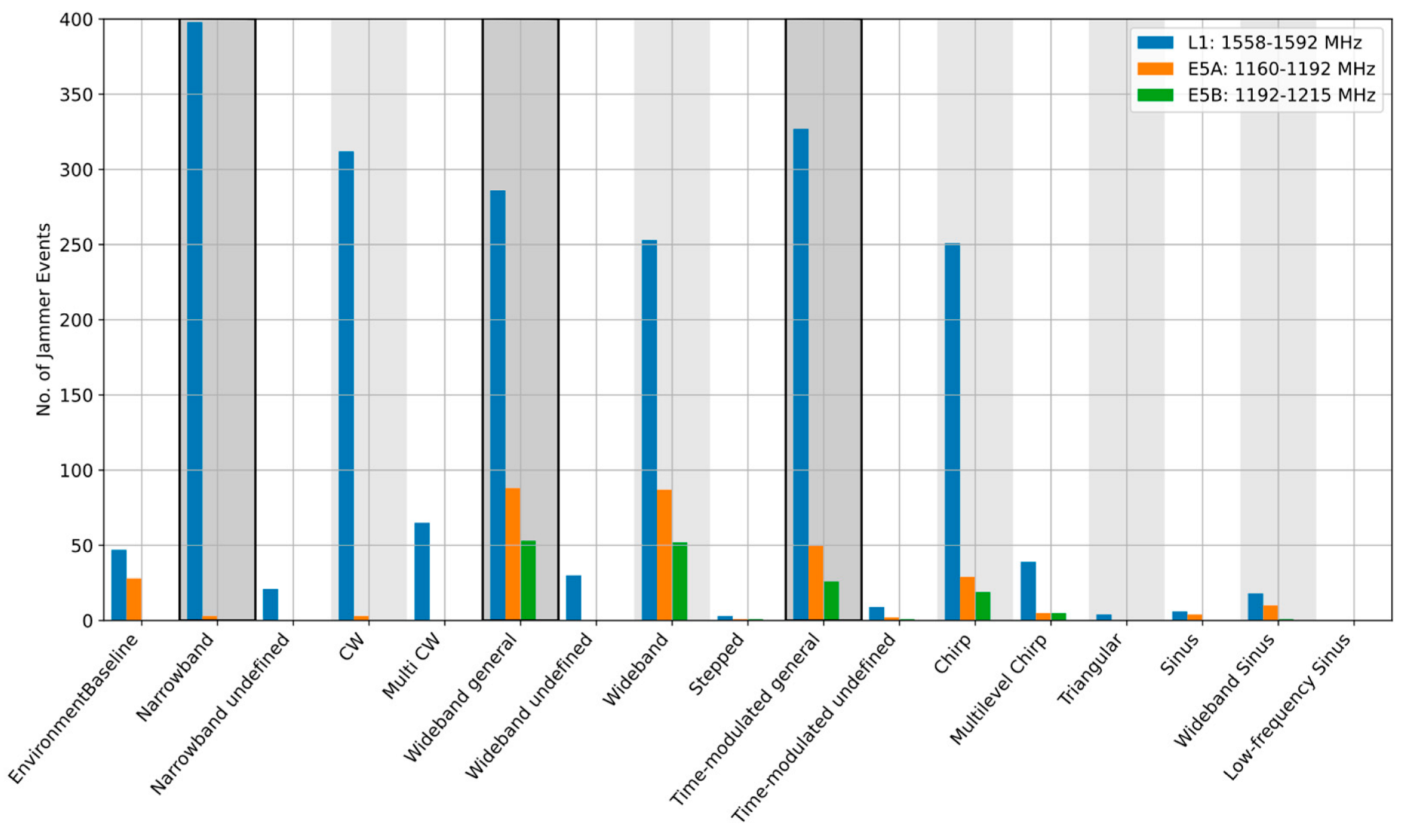
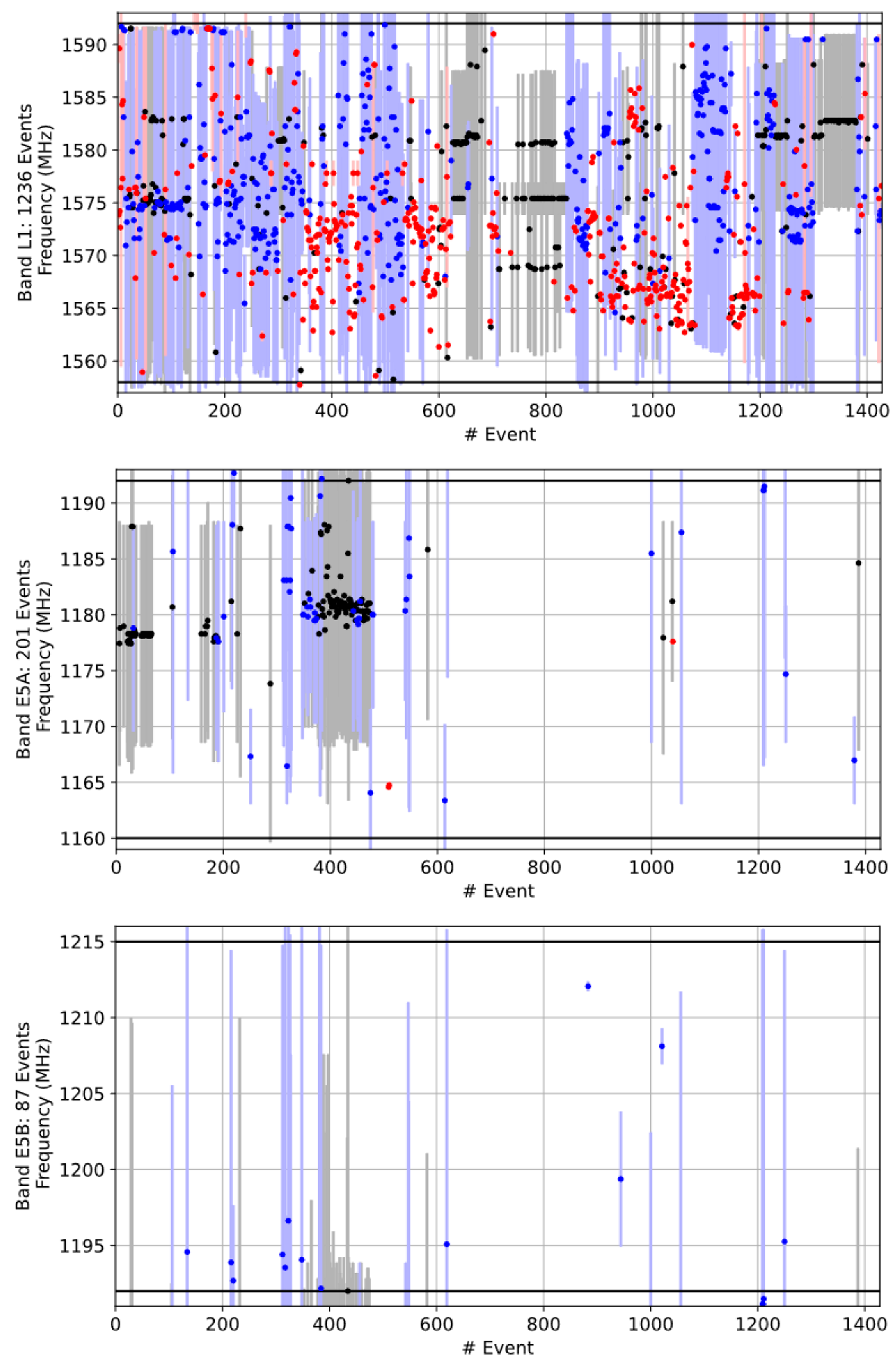
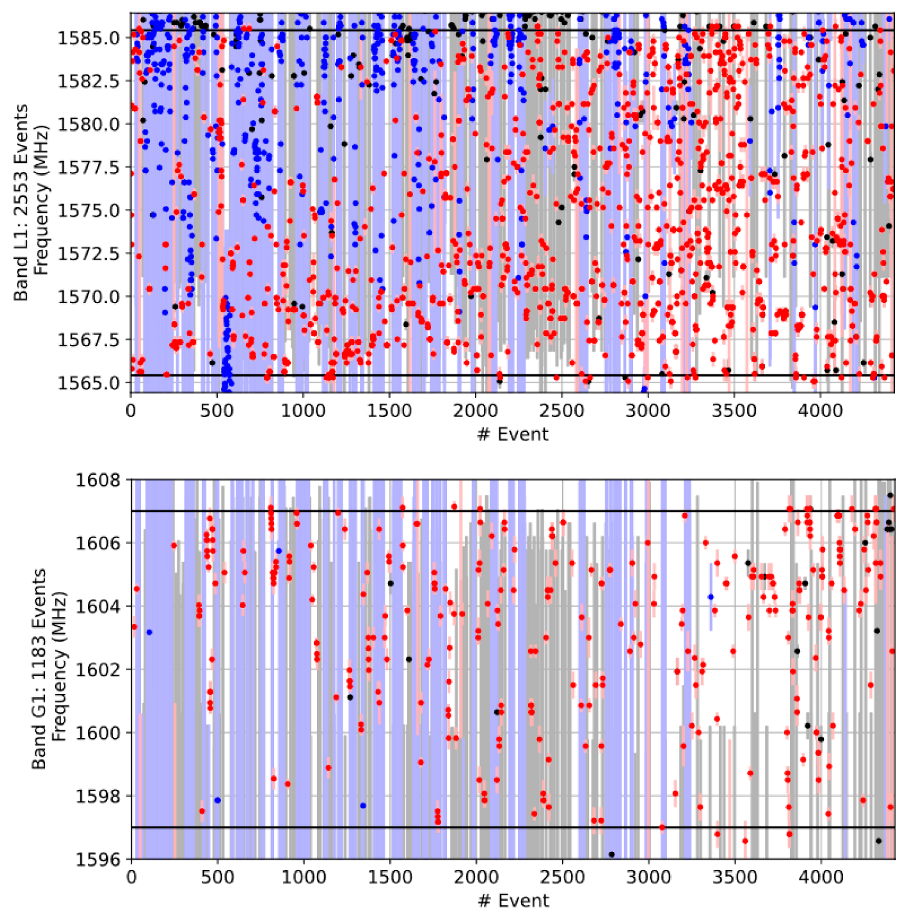

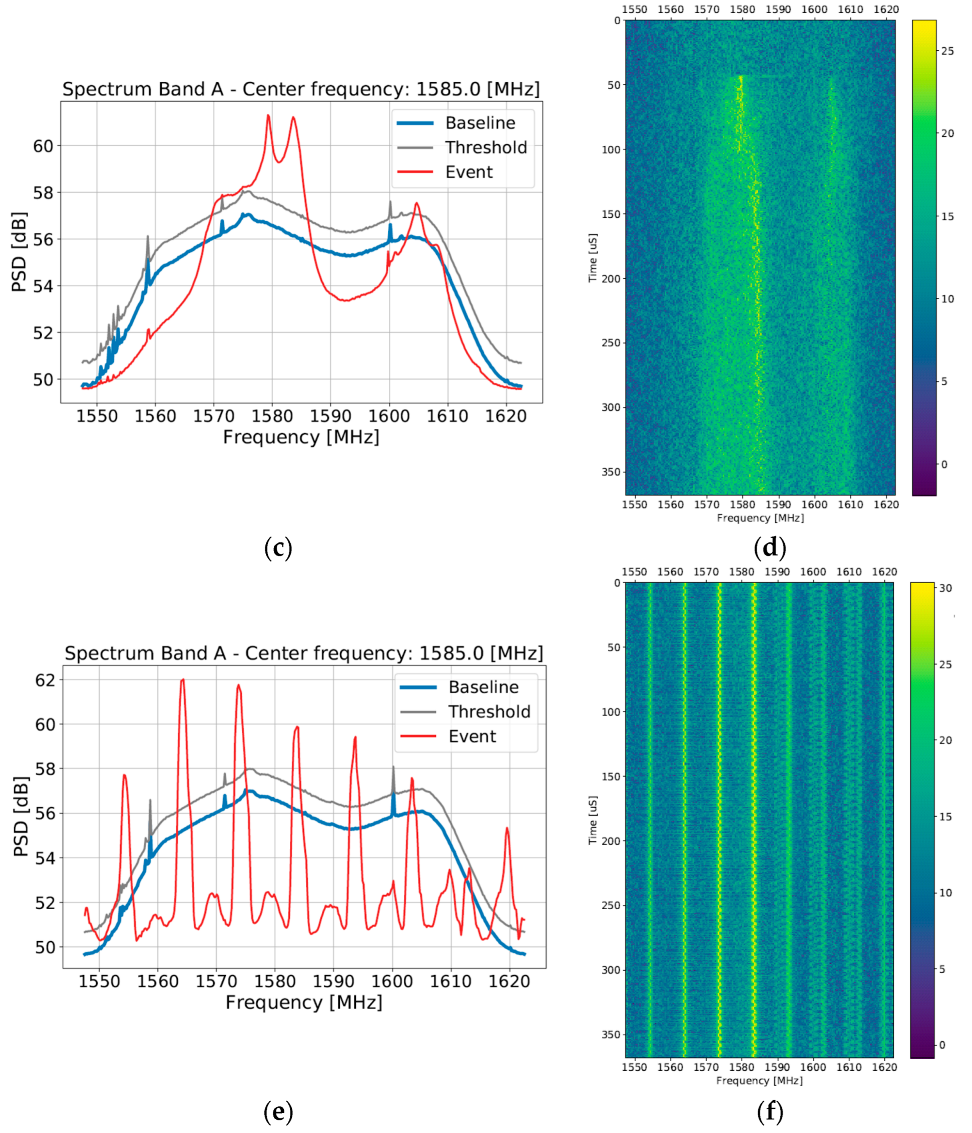
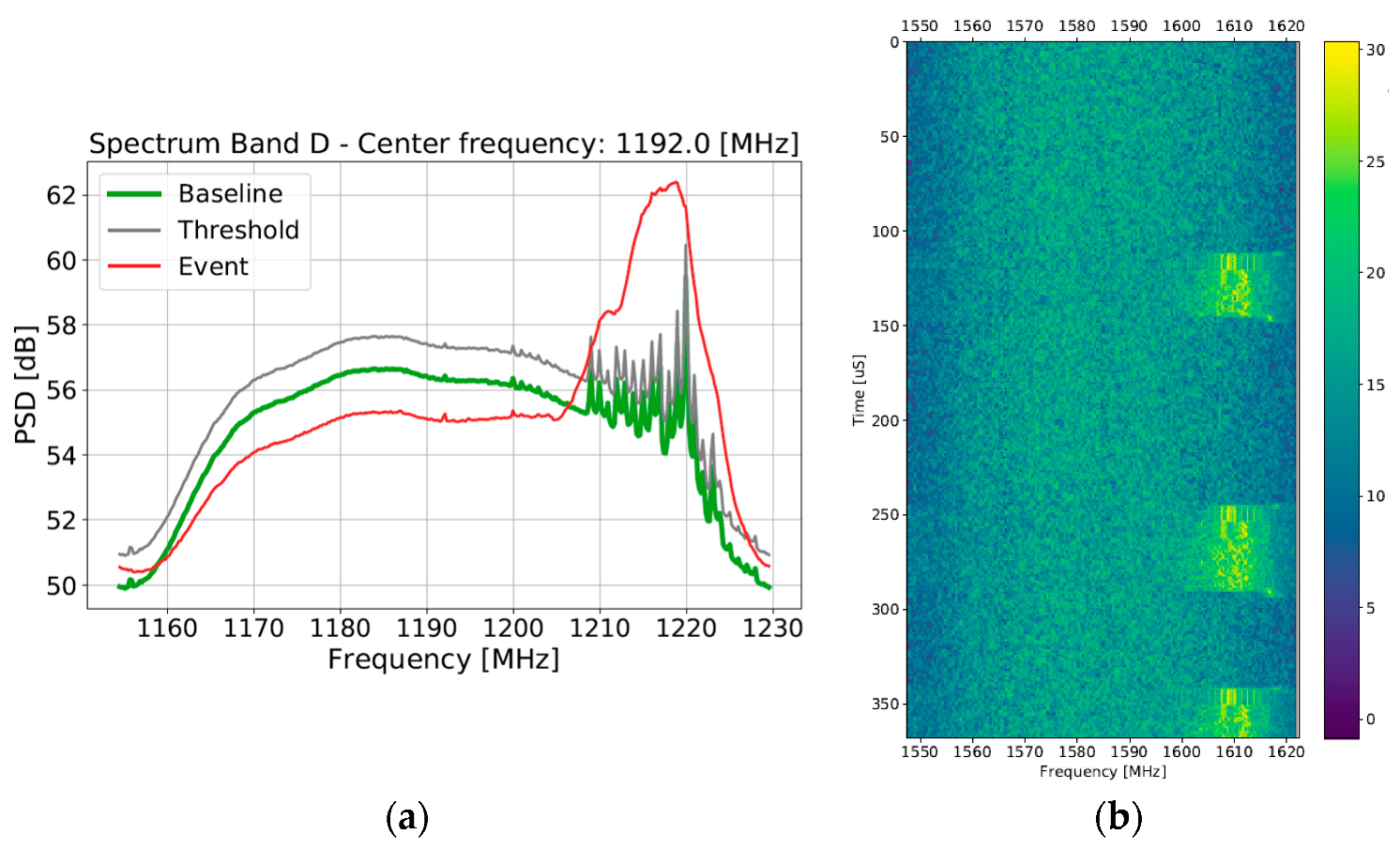
| Frequency Band | Band Limits (MHz) |
|---|---|
| L1/E1 | 1558–1591 |
| L5/E5a | 1160–1192 |
| E5b | 1192–1215 |
| Site | L1/E1 | L5 (E5a) | E5b |
|---|---|---|---|
| Moss | Narrowband | Time-modulated | Time-modulated |
| Trondheim | Narrowband/Time-modulated | Time-modulated | Time-modulated |
| Trondheim B | Time-modulated | Wideband | Wideband |
| Trondheim C | Time-modulated/Narrowband | Wideband/Time-modulated | Wideband/Time-modulated |
| Asker | Wideband | Wideband | Wideband |
| Amsterdam | Time-modulated/Narrowband/Wideband | Wideband | Time-modulated |
| Average RFI Presence per Day (Seconds) | |||||||||
|---|---|---|---|---|---|---|---|---|---|
| Site | Days of Observation | Number of Events | All Bands Accumulated | L1/E1 | L5/E5a | E5b | L1/E1 + E5a | L1/E1 + E5b | L1/E1 + E5a + E5b |
| Moss | 463 | 5670 | 30.2 | 29.3 | 7.2 | 5.5 | 6.0 | 4.9 | 4.6 |
| Trondheim | 561 | 2551 | 17.3 | 15.6 | 2.1 | 3.0 | 1.4 | 1.4 | 1.3 |
| Trondheim B | 535 | 909 | 7.8 | 7.5 | 1.5 | 1.7 | 1.3 | 1.4 | 1.3 |
| Trondheim C | 730 | 5016 | 37.9 | 32.4 | 11.2 | 10.7 | 6.8 | 5.7 | 5.6 |
| Asker | 342 | 1444 | 19.2 | 17.9 | 7.3 | 6.6 | 6.0 | 6.4 | 5.7 |
| Amsterdam | 485 | 2183 | 27.7 | 27.6 | 3.9 | 1.5 | 3.8 | 1.5 | 1.4 |
| Total | 3116 | 18,600 | |||||||
| Average | 23.4 | 21.7 | 5.5 | 4.8 | 4.2 | 3.6 | 3.3 | ||
| Occurrence Ratios | |||||
|---|---|---|---|---|---|
| L1/E1 vs. L5/E5a | L1/E1 vs. E5b | L1/E1 vs. L1/E1 + L5/E5a | L1/E1 vs. L1/E1 + E5b | L1/E1 vs. L1/E1 + L5/E5a + E5b | E5a vs. E5b |
| 3.9 | 4.5 | 5.1 | 6.1 | 6.5 | 1.1 |
| Probability of RFI Occurrence | ||||||
|---|---|---|---|---|---|---|
| Site | L1/E1 | L5/E5a | E5b | L1/E1 + L5/E5a | L1/E1 + E5b | L1/E1 + E5a + E5b |
| Moss | 3.34 × 10−4 | 8.30 × 10−5 | 6.37 × 10−5 | 7.00 × 10−5 | 5.65 × 10−5 | 5.32 × 10−5 |
| Trondheim | 1.80× 10−4 | 2.42 × 10−5 | 3.52 × 10−5 | 1.5 × 10−5 | 1.57 × 10−5 | 1.47 × 10−5 |
| Trondheim B | 8.67 × 10−5 | 1.74 × 10−5 | 1.96 × 10−5 | 1.53 × 10−5 | 1.66 × 10−5 | 1.53 × 10−5 |
| Trondheim C | 3.75 × 10−4 | 1.30 × 10−4 | 1.24 × 10−4 | 7.91 × 10−5 | 6.63 × 10−5 | 6.54 × 10−5 |
| Asker | 2.07 × 10−4 | 8.40 × 10−5 | 7.58 × 10−5 | 6.96 × 10−5 | 7.46 × 10−5 | 6.55 × 10−5 |
| Amsterdam | 3.20 × 10−4 | 4.52 × 10−5 | 1.76 × 10−5 | 4.44 × 10−5 | 1.72 × 10−5 | 1.68 × 10−5 |
| Unweighted average | 2.50 × 10−4 | 6.39 × 10−5 | 5.60 × 10−5 | 4.90 × 10−5 | 4.12 × 10−5 | 3.85 × 10−5 |
| Frequency Band | Band Limits (MHz) |
|---|---|
| L1/E1 | 1565–1585 |
| G1 | 1592–1612 |
| Site | Dominant RFI Type on L1/E1 (1575.42 MHz ± 10 MHz) | Dominant RFI Type on G1 (1602.00 MHz ± 10 MHz) |
|---|---|---|
| Moss | Narrowband | Time-modulated/Narrowband |
| Trondheim | Narrowband/Time-modulated | Time-modulated |
| Trondheim B | Time-modulated/Narrowband | Time-modulated |
| Trondheim C | Time-modulated/Narrowband | Time-modulated |
| Asker | Wideband | Wideband |
Publisher’s Note: MDPI stays neutral with regard to jurisdictional claims in published maps and institutional affiliations. |
© 2022 by the authors. Licensee MDPI, Basel, Switzerland. This article is an open access article distributed under the terms and conditions of the Creative Commons Attribution (CC BY) license (https://creativecommons.org/licenses/by/4.0/).
Share and Cite
Sokolova, N.; Morrison, A.; Diez, A. Characterization of the GNSS RFI Threat to DFMC GBAS Signal Bands. Sensors 2022, 22, 8587. https://doi.org/10.3390/s22228587
Sokolova N, Morrison A, Diez A. Characterization of the GNSS RFI Threat to DFMC GBAS Signal Bands. Sensors. 2022; 22(22):8587. https://doi.org/10.3390/s22228587
Chicago/Turabian StyleSokolova, Nadezda, Aiden Morrison, and Anja Diez. 2022. "Characterization of the GNSS RFI Threat to DFMC GBAS Signal Bands" Sensors 22, no. 22: 8587. https://doi.org/10.3390/s22228587
APA StyleSokolova, N., Morrison, A., & Diez, A. (2022). Characterization of the GNSS RFI Threat to DFMC GBAS Signal Bands. Sensors, 22(22), 8587. https://doi.org/10.3390/s22228587







